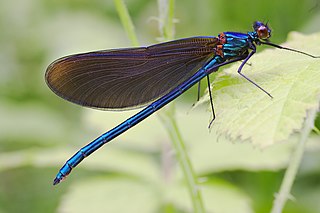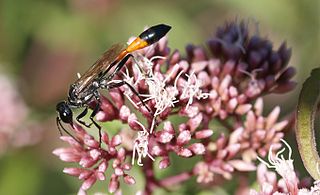
Odonata is an order of flying insects that includes the dragonflies and damselflies. Like most other flying insects, they evolved in the early Mesozoic era. Their prototypes, the giant dragonflies of the Carboniferous, 325 mya, are no longer placed in the Odonata but included in the Protodonata or Meganisoptera.
A common classification of the Lepidoptera involves their differentiation into butterflies and moths. Butterflies are a natural monophyletic group, often given the suborder Rhopalocera, which includes Papilionoidea, Hesperiidae (skippers), and Hedylidae. In this taxonomic scheme, moths belong to the suborder Heterocera. Other taxonomic schemes have been proposed, the most common putting the butterflies into the suborder Ditrysia and then the "superfamily" Papilionoidea and ignoring a classification for moths.

Damselflies are insects of the suborder Zygoptera in the order Odonata. They are similar to dragonflies, which constitute the other odonatan suborder, Anisoptera, but are smaller and have slimmer bodies. Most species fold the wings along the body when at rest, unlike dragonflies which hold the wings flat and away from the body. An ancient group, damselflies have existed since at least the Lower Permian, and are found on every continent except Antarctica.

Hemiptera or true bugs are an order of insects comprising over 80,000 species within groups such as the cicadas, aphids, planthoppers, leafhoppers, bed bugs and shield bugs. They range in size from 1 mm (0.04 in) to around 15 cm (6 in), and share a common arrangement of sucking mouthparts. The name "true bugs" is often limited to the suborder Heteroptera. Many insects commonly known as "bugs", especially in American English, belong to other orders; for example, the lovebug is a fly and the May bug and ladybug are beetles.

In biology, a nymph is the immature form of some invertebrates, particularly insects, which undergoes gradual metamorphosis (hemimetabolism) before reaching its adult stage. Unlike a typical larva, a nymph's overall form already resembles that of the adult, except for a lack of wings. In addition, while a nymph moults, it never enters a pupal stage. Instead, the final moult results in an adult insect. Nymphs undergo multiple stages of development called instars.

Earwigs make up the insect order Dermaptera. With about 2,000 species in 12 families, they are one of the smaller insect orders. Earwigs have characteristic cerci, a pair of forcep-like pincers on their abdomen, and membranous wings folded underneath short, rarely used forewings, hence the scientific order name, "skin wings". Some groups are tiny parasites on mammals and lack the typical pincers. Earwigs are found on all continents except Antarctica.

Mayflies are aquatic insects belonging to the order Ephemeroptera. This order is part of an ancient group of insects termed the Palaeoptera, which also contains dragonflies and damselflies. Over 3,000 species of mayfly are known worldwide, grouped into over 400 genera in 42 families.

The Gerridae are a family of insects in the order Hemiptera, commonly known as water striders, water skeeters, water scooters, water bugs, pond skaters, water skippers, Jesus bugs, or water skimmers. Consistent with the classification of the Gerridae as true bugs, gerrids have mouthparts evolved for piercing and sucking, and distinguish themselves by having the unusual ability to walk on water, making them pleuston (surface-living) animals. They are anatomically built to transfer their weight to be able to run on top of the water's surface. As a result, one could likely find water striders present in any pond, river, or lake. Over 1,700 species of gerrids have been described, 10% of them being marine.
The most recent understanding of the evolution of insects is based on studies of the following branches of science: molecular biology, insect morphology, paleontology, insect taxonomy, evolution, embryology, bioinformatics and scientific computing. It is estimated that the class of insects originated on Earth about 480 million years ago, in the Ordovician, at about the same time terrestrial plants appeared. Insects may have evolved from a group of crustaceans. The first insects were landbound, but about 400 million years ago in the Devonian period one lineage of insects evolved flight, the first animals to do so. The oldest insect fossil has been proposed to be Rhyniognatha hirsti, estimated to be 400 million years old, but the insect identity of the fossil has been contested. Global climate conditions changed several times during the history of Earth, and along with it the diversity of insects. The Pterygotes underwent a major radiation in the Carboniferous while the Endopterygota underwent another major radiation in the Permian.

The Calopterygidae are a family of damselflies, in the suborder Zygoptera. They are commonly known as the broad-winged damselflies, demoiselles, or jewelwings. These rather large damselflies have wingspans of 50–80 mm and are often metallic-coloured. The family contains some 150 species.

Insect wings are adult outgrowths of the insect exoskeleton that enable insects to fly. They are found on the second and third thoracic segments, and the two pairs are often referred to as the forewings and hindwings, respectively, though a few insects lack hindwings, even rudiments. The wings are strengthened by a number of longitudinal veins, which often have cross-connections that form closed "cells" in the membrane. The patterns resulting from the fusion and cross-connection of the wing veins are often diagnostic for different evolutionary lineages and can be used for identification to the family or even genus level in many orders of insects.

In entomology, petiole is the technical term for the narrow waist of some hymenopteran insects, especially ants, bees, and wasps in the suborder Apocrita.

Ephemera danica, the green drake or green drake mayfly, is a species of mayfly in the genus Ephemera.
Archidermapteron martynovi is an extinct species of earwig, in the genus Archidermapteron, family Protodiplatyidae, the suborder Archidermaptera, the order Dermaptera, and is the only species in the genus Archidermapteron, which simply means "ancient member of the Dermaptera". It had long, segmented cerci unlike modern species of Dermaptera, but tegmina and hind wings that folded up into a "wing package" that are like modern earwigs. The only clear fossil of the species was found in Russia.

Coxoplectoptera or "chimera wings" is an extinct order of winged insects containing one family, Mickoleitiidae. Coxoplectopterans are closely related to the mayflies.

Pannota is a suborder of mayflies. One of the differences between this suborder and its sister group Schistonota concerns the degree of fusion of the wing pads in the final-stage nymph; in Schistonota, the degree of fusion along the mesothorax is more than half the fore-wing length while in Pannota the degree of fusion is less than half that length. Other differences between the two groups include the morphology of the gills and also behavioural differences. Schistonota nymphs are mostly active swimmers, burrowers and sprawlers, while Pannota nymphs are more passive, slow-moving crawlers.

Ephemerelloidea is a superfamily of mayflies in the suborder Pannota. It is a basal group of mayflies with a worldwide distribution. Members of this super-family can be distinguished from those of Caenoidea by the fact that the gills of the nymphs are not filamentous.
Dolania is a monotypic genus of mayfly in the family Behningiidae containing the single species Dolania americana. It is found in the southeastern United States, as far south as Florida, and is generally uncommon. The adult insects emerge before dawn in early summer, mate and die within the space of about thirty minutes. The female deposits her eggs in the water and dies within five minutes of emergence, believed to be the shortest adult lifespan of any insect.

Ephemera simulans is a species of mayfly. It is commonly found throughout the United States. The species is used for fly fishing.
















